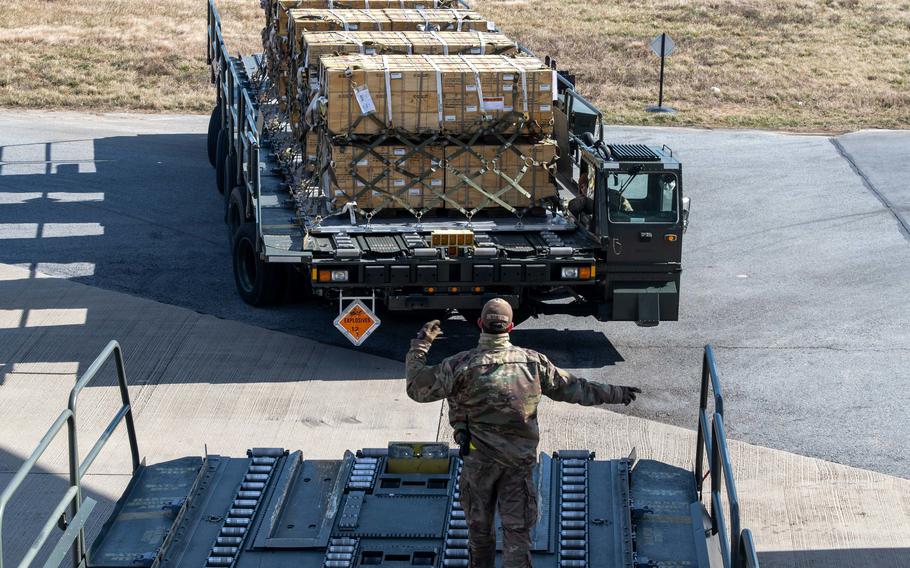
Senior Airman Cameron Manson, a 436th Aerial Port Squadron ramp operation specialist, helps load cargo on Feb. 3, 2023, during a security assistance mission at Dover Air Force Base, Del. ( Faith Barron/U.S. Air Force)
WASHINGTON — The Pentagon has found no evidence that U.S. military aid earmarked for Ukraine has been diverted for unauthorized uses, defense officials told House lawmakers Tuesday to allay congressional fears that weapons could be falling into the wrong hands.
The Pentagon’s comprehensive oversight efforts for nearly $32 billion in security assistance for Ukraine’s defense against Russia’s invasion is successfully working to track and account for military equipment, officials said during a hearing of the House Armed Services Committee.
“We think the Ukrainians are using properly what they’ve been given,” said Colin Kahl, the undersecretary of defense for policy.
Robert Storch, the Defense Department’s inspector general, detailed a vast accountability system that the U.S. has set up to watch over the material being sent to Ukraine in the past year. More than 90 employees are conducting oversight and the department has about 20 ongoing and planned audits and evaluations focused on ensuring U.S. tax dollars are being spent properly, he said.
The Pentagon is also partnering with inspector generals at the State Department and the U.S. Agency for International Development to monitor more than $113 billion in total aid to Ukraine, about 60% of which is military assistance, Storch said.
“We’re laser focused on this issue,” he said. “We’re doing audits and evaluations that look at the weapons from the time they begin at the port, while they’re transferred, as they get to the transshipment points and then go into the country.”
Ukrainians have been provided with tracking systems, including hand-held scanners and logistics software, to keep tabs on the equipment, Kahl said. The limited military personnel at the U.S. Embassy in Kyiv, the Ukrainian capital, also has conducted six site visits to provide additional oversight.
“We don’t see any evidence of diversion in our reporting,” he said. “But we’ll continue to foot stomp the importance of accountability and transparency.”
Ukraine’s long history of corruption has been a top concern for defense officials since the U.S. began actively assisting Ukraine’s military nine years ago, Kahl said. But there has been progress in that area, he said, especially in the defense sector.
Rep. Joe Courtney, D-Conn., noted Ukraine’s position on a corruption index compiled by the group Transparency International has improved in the past year and praised Ukrainian President Volodymyr Zelenskyy’s recent crackdown on graft within his government.
“I would say he courageously took steps to remove officials, some very close even to his office and political supporters of his own, which shows, I think, a tremendous commitment to not just talking about trying to address this problem,” Courtney said. “I think that should be acknowledged in terms of the seriousness with which he and his administration are pursuing this goal.”
Rep. Adam Smith of Washington, the top Democrat on the committee, said Ukraine’s success on the battlefield — defying many expectations that the country would fall to a Russian assault in a matter of days — has shown that U.S. aid is going where it needs to go.
“If the weapons and equipment and support that we were sending them was being sent elsewhere or stolen or misused, they would have lost a long time ago,” he said.
Republicans have been more skeptical of U.S. assistance to Ukraine, with a vocal minority arguing to put an end to it. Reps. Matt Gaetz, R-Fla., and Mike Johnson, R-La., on Tuesday raised concerns over the challenges of conducting end-use monitoring in a country with no active U.S. military presence.
Kahl acknowledged those difficulties but said safeguards are in place to make certain Ukrainians are not misusing U.S. aid. Ukrainian officials are regularly providing information from their inventories and transfer logs, and data from NATO-standard scanners is being transmitted directly to the U.S., he said.
A “couple dozen” military personnel from the U.S. Embassy’s Office of Defense Cooperation are also making day trips to sites outside Kyiv when it is safe to do so, Kahl said.
“This is an active combat zone, it’s not like Iraq and Afghanistan where we had thousands of soldiers all over the country so there are inherent restrictions,” he said. “But we’re trying to maximize the use of technology and the people we do have on the ground to get the best sight picture as possible.”